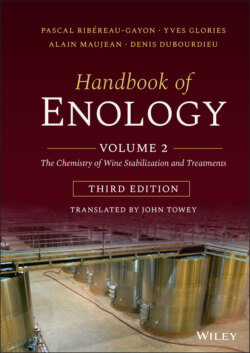Читать книгу Handbook of Enology, Volume 2 - Pascal Ribéreau-Gayon - Страница 50
2.2.1 Methanol
ОглавлениеMethanol is always present in wine in very small quantities, between 60 and 150 mg/l. It has no organoleptic impact. Methanol is not formed by alcoholic fermentation, but results exclusively from enzymatic hydrolysis of the methoxyl groups of pectins during fermentation to form pectic acids:
As grapes have a relatively low pectin content, wine is the fermented beverage with the lowest methanol concentration.
Methanol content depends on the extent to which the grape solids, especially the pectin‐rich skins, are macerated. Red wines have a higher concentration (152 mg/l) than rosés (91 mg/l), while white wines have even less (63 mg/l) (Ribéreau‐Gayon et al., 1982). Wines made from hybrid grape varieties have a higher methanol content than those made from Vitis vinifera. This is due to the higher pectin content of hybrid grape skins. The use of pectolytic enzymes to facilitate extraction or clarification of the must may cause an increase in methanol as a result of the pectin esterase activity.
Methanol's toxicity is well known. Following ingestion, it oxidizes to produce formaldehyde and formic acid, both toxic to the central nervous system. Formaldehyde damages the optical nerve, causing blindness. Wines made in the normal way never have methanol concentrations anywhere near hazardous levels (Skrzydlewska, 2003).
